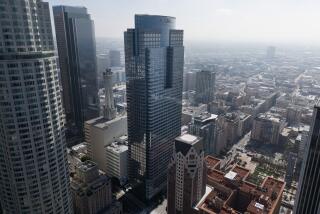Fewer Skyscrapers Likely to Be Built in Shadow of Attack
The sight of Manhattan’s tallest buildings crumbling has triggered concern among the dwellers of other landmark buildings and raised questions about the long-term viability and status of the American skyscraper.
The high-profile, prestige and size that attract image-conscious businesses to such buildings are the same features that make them attractive targets, say terrorism experts.
That perception weighed on real estate executive C. Frederick Wehba II, who felt vulnerable in his perch above Century City a day after the destruction of the World Trade Center.
“I’m concerned that the same thing will happen to us,” said Wehba, whose office is located about halfway up one of the twin, 44-story Century Plaza Towers that dominate the Century City skyline. “It’s one of the highest-profile locations in the city.”
Newly raised safety concerns will make it more difficult to build large towers in the U.S., where huge development costs and changes in urban development tastes and business culture have already made skyscraper groundbreakings rare.
“There is going to be some hard thinking that will be done before building such trophy towers in downtown Manhattan or in any other places across the globe,” said Stuart Gabriel, director of USC’s Lusk Center for Real Estate. “The watchword of the day will be ‘low-profile.’ ”
Despite security risks, there is a long list of tenants willing to pay top dollar for a penthouse boardroom or rooftop signage.
“If you look at the psychology of a tall building, it’s a masculine statement of ego,” said architect Thom Mayne of the Santa Monica-based firm Morphosis. “It’s clearly about power.”
The World Trade Center attack unnerved architect Rick Keating, but it has not diminished his interest in Los Angeles’ tallest building, the 73-story Library Tower. “It knows it’s at the center of the city with its shoulders high,” said Keating, who is eyeing space on the building’s 57th floor.
Robert Maguire, the developer of Library Tower and several other downtown landmarks, said an act of terrorism can take place anywhere.
“I don’t think [this] will have any impact in terms of changing the forms of building in this country,” Maguire said.
Tempting Targets for Terrorists
But corporate skyscrapers, like military installations, are tempting targets for terrorists because they are symbols of establishment power and their destruction can undermine a society’s sense of security, say security consultants.
And prominent office towers are more vulnerable than military bases or government buildings, said Ben Venzke, chief executive of IntelCenter, a private intelligence consulting firm.
“Because of their size and their nature, [skyscrapers] are extremely difficult in [open] societies like ours to protect,” Venzke said, “especially if the attacker does not care about being caught or losing their life.”
That has put many skyscraper dwellers on edge.
“Absolutely, I’m concerned 2,000%,” said Monica Dolgin, an administrative staffer at Greif & Co., a financial firm on the 65th floor of Library Tower. “I don’t think [we’re] a target. But since I’m in the highest building downtown, I don’t feel safe.”
Now, high-rise landlords are under pressure to pay for more security or perhaps face the defection of tenants or the need to lower rents, say real estate observers.
After the 1995 bombing of the federal building in Oklahoma City, government designers adopted such new design features as barricades between traffic and building entrances and prohibiting the placement of parking garages directly underneath buildings. But private builders have been slower to adopt these features, which often limit convenience and access.
“The private industry could react to the acts of yesterday by looking at those [government} design standards,” said Los Angeles architect and skyscraper specialist Scott Johnson, whose 35-story MGM Tower is under construction in Century City.
Still, no one anticipates a surge in skyscraper construction even if more protective features are added.
After a boom of skyscraper development during the 1980s, corporate America and developers shifted gears and embraced low-rise, campus-style office parks in suburban location where land was cheap and close to employees. Sears, Roebuck & Co., for example, moved its headquarters out of the tallest building in the nation--the Sears Tower in Chicago--to a low-rise complex in the suburbs in 1993.
Despite the revival of central cities in recent years, the vast majority of new office construction remains in suburban locations. “There is less of an emphasis on Downtown America,” said USC’s Gabriel.
The notion that a tall building is the only way to symbolize status and power will be increasingly challenged, particularly in locations outside of dense urban centers.
Times staff writer Melinda Fulmer and Bloomberg News contributed to this report.
More to Read
Inside the business of entertainment
The Wide Shot brings you news, analysis and insights on everything from streaming wars to production — and what it all means for the future.
You may occasionally receive promotional content from the Los Angeles Times.










